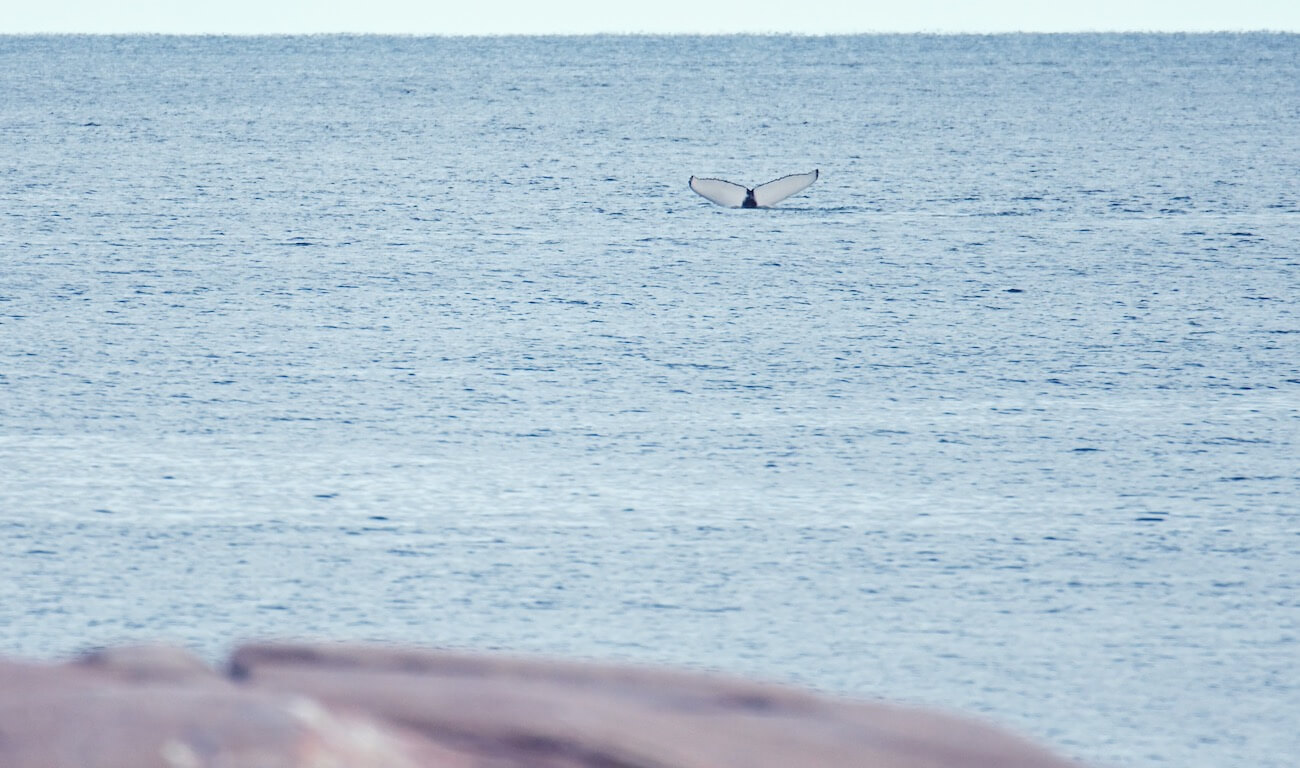As November winds down, the snow gently reminds us that winter temperatures are right around the corner. With most of the region’s boats now out of the water for the season, only those brave enough to venture out onto the riverbanks will get to see whales or seals! To have a chance to see marine mammals, observers will now have to be patient and dressed for the elements.
Nevertheless, the list of marine mammal sightings this week is joyously colourful! Reports from the estuary include minke whales, belugas, harbour porpoises as well as all three species of St. Lawrence seals. As for humpbacks, three individuals were observed in the estuary while others seem to be leaving the sector, quietly working their way long the coasts.
Blending in with the ice floes
“The white belugas against the snowy backdrop is just awesome,” marvels one cetacean buff who had the chance to spot these animals from Tadoussac in the mouth of the Saguenay. The few flakes that have fallen in recent days seem to melt into the backs of these white whales when they pierce the water surface. The colour of these cetaceans also serves as a sort of camouflage, allowing them to blend into their winter decor of ice floes and icebergs. This enables them to avoid their main predators, including killer whales, polar bears, and humans.
Each at its own pace
In Gaspé Bay, the days of watching whales are increasingly quiet, though one can always count on the seals at Cap-aux-Os beach to cheer up a few daring observers. A minke whale was also seen, as was a mysterious blow that caught the attention of one observer as she was scanning the sea: “I saw the spout in the middle of the bay a bit by luck! With the distance and the wind, it’s hard to say for sure what species it was, but I’m leaning toward a humpback.”
Is it one of the two humpbacks that previously spent a few days off the coast of Franquelin? No one can say! The sound of their blasts nevertheless entertained the residents who ventured onto the water’s edge to admire them. The two animals appeared to be heading toward the gulf.
As humpbacks migrate to the Caribbean in the fall, perhaps they were on their way to their winter breeding grounds? If this is the case, a marathon journey of over than 5,500 kilometres awaits them. They will spend the winter in large groups, bathing in the more temperate waters and living off the fat reserves they so preciously built up over the previous summer. Even if several humpbacks are still in the St. Lawrence, others have already arrived in Guadeloupe, according to the social networks of the local marine mammal observatory. The first member of the species was already purportedly observed there on November 15!
Diversity in the estuary
From Cap de Bon-Désir in Les Bergeronnes, a stunning series of observations was made over the past week. “Three humpbacks, at least four minkes, a handful of belugas, several dozen porpoises, a few harbour seals, a herd of over 100 harp seals and a single grey seal,” rattles off one naturalist and animal photographer, who even managed to identify the humpbacks.
One of these individuals was Queen, whose mainly white caudal fin has a black line on the right lobe. Her tail also shows a white line on the dorsal side. This whale was first seen in 2017 in Gaspé with its mother (H489) by researchers from the Mingan Island Cetacean Study (MICS).
From Tadoussac, a seal happily devouring its meal surprises one resident: “We observed a harbour seal gobbling down something, only we don’t know what, as we couldn’t get to our binoculars fast enough. Then it disappeared with its prey. It was hilarious! We saw it holding something in its flippers and pulling at it with its mouth with all its might, or so it seemed.”
From Franquelin comes a report of a minke whale also feeding close to shore, while a little farther offshore, harbour porpoises and grey seals frolicked in the waves.
Thanks to all our collaborators!
Special thanks go out to all our observers who share their love for marine mammals with us! Whether it’s every week or just a few times throughout the summer, the stories of your encounters with cetaceans and pinnipeds are always a pleasure to read and discover.
On the water or from shore, it is your eyes that give life to this column.
Laetitia Desbordes
Diane Ostiguy
Sandrine Papias
Renaud Pintiaux
Pascal Pitre
Christine Stadelmann
Louis-Pierre Ducharme-Tremblay
Andréanne Sylvain
Marielle Vanasse
And all those we left out!
Additionally, we would like to acknowledge the following teams for also sharing their sightings:
Mingan Island Cetacean Study (MICS)
Marine Mammal Observation Network (ROMM)
Quebec Marine Mammal Emergency Response Network: Status Report (QMMERN)
Group for Research and Education on Marine Mammals (GREMM)
Would you also like to share your observations?
Have you seen any marine mammals in the St. Lawrence? Whether it’s a spout offshore or just a couple of seals, drop us a line and send your photos to [email protected]!








